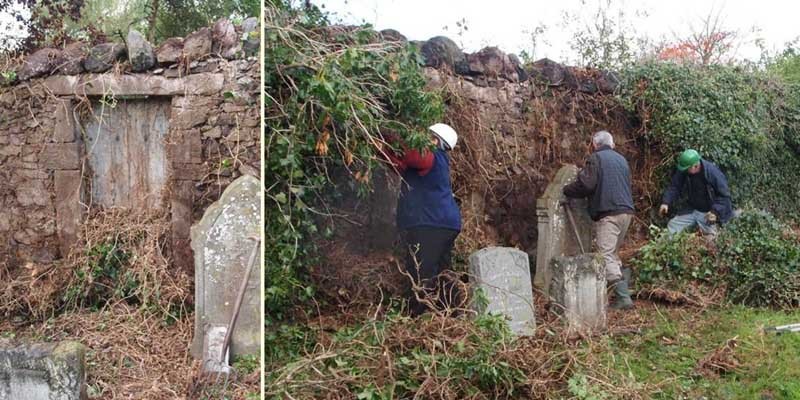Workers have uncovered a centuries-old gateway which may have been used by William Wallace.
Volunteers hacking ivy from a wall at Kilspindie Church revealed a stopped-up gap which would once have linked the church to the adjacent Kilspindie Castle.
The Carse of Gowrie castle was once the home of Wallace’s uncle and it is thought the hero of the Wars of Independence may have stayed there for periods of his life.
According to the account of his life by the minstrel, Blind Harry, he was educated in nearby Dundee.
In 1291, the young Wallace was said to have struck down a young English nobleman on a trip to the city.
Having been branded an outlaw, he fled back to Kilspindie briefly but remained a fugitive from the law until his eventual capture by the English 14 years later.
The gateway was exposed as locals worked on the Historic Churchyards Project, led by Fiona Fisher of Perth and Kinross Heritage Trust.
She said: ”Hidden underneath the heavy cladding of ivy was an ordinary looking gateway which may have an extraordinary history.
”The gateway once linked Kilspindie Castle to the church and it is said that Wallace walked through this gateway to the parish church.
”Kilspindie Farm House is on the site of Kilspindie Castle which was once the home of his uncle.
”According to the chronicler Blind Harry, who claimed to have based his work on the diaries of John Blair, Wallace’s mother’s private chaplain, he resided at the castle after the death of Alexander III in 1286, when he would have been 16.”
She does concede it is ”unlikely” the wall and gateway are the same ones but the possibility remains.
Repairs to the wall, which has collapsed in one place and is leaning and has loose stones in others, are under discussion with the owners of Kilspindie Farm House and Perth and Kinross Council. It is proposed to repair the wall and reinstate the wooden gate.
Wallace raised an army and went on to defeat the English at Stirling Bridge in 1297 but was later soundly beaten near Falkirk and captured soon afterwards.
He was hung, drawn and quartered in London in 1305.
Parts of his body were sent around the country as a warning to other rebels, with one of his limbs sent to Perth for public display.Tayside’s historic heroWilliam Wallace had close connections to Tayside.
A minor noble, he was sent from his Ayrshire home to Dundee to finish his education under the charge of William Mydford, the Vicar of Dundee.
After killing Selby, the son of Dundee’s constable, he is said to have fled the West Port by Hawkhill then by the main road towards Perth.
He was almost caught at Longforgan but, disguised as a spinner, escaped detection and was led to Kilspindie.
The grinding stone on which he supposedly sat in the village is now in the McManus Galleries.
From Kilspindie he made good his escape to Dunfermline.
During the later Wars of Independence, Wallace swept through Perth and, based at Coupar Angus, captured Forfar, Brechin and Dunnottar castles.
He broke off his siege of the Castle of Dundee to win the Battle of Stirling Bridge.
The siege was completed by Sir Alexander Scrymgeour.
One of the houses in the current Dundee High School is named for its famous former pupil and a plaque was erected on Dundee High Street commemorating his time in the city.
No accounts survive of where in Perth the mutilated section of Wallace’s torso was displayed after his grisly death.
